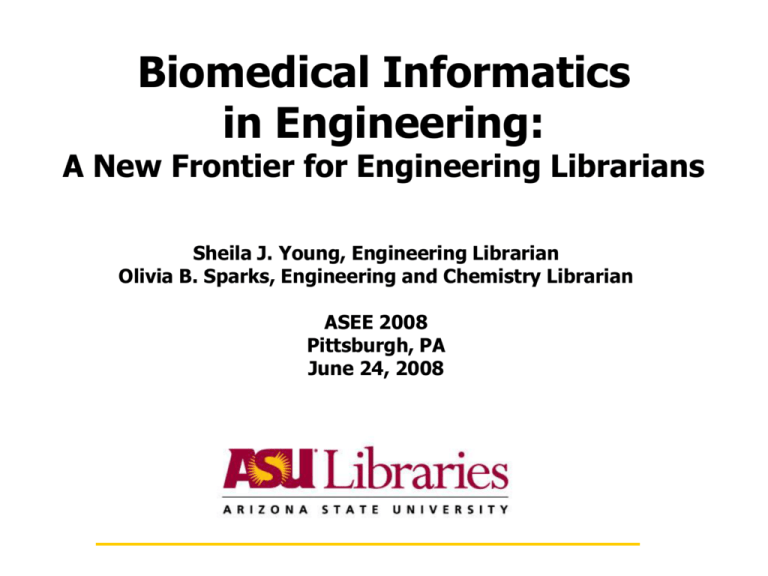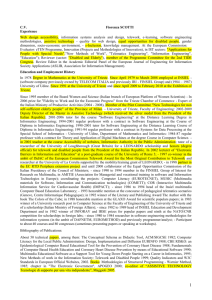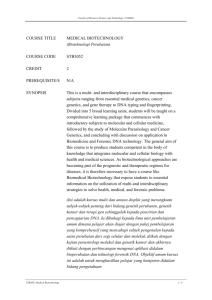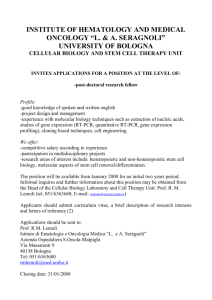Biomedical Informatics in Engineering
advertisement

Biomedical Informatics in Engineering: A New Frontier for Engineering Librarians Sheila J. Young, Engineering Librarian Olivia B. Sparks, Engineering and Chemistry Librarian ASEE 2008 Pittsburgh, PA June 24, 2008 Biomedical Informatics http://www.dbmi.columbia.edu/about/definition/definition.html Shortliffe & Cimino, 2006. Biomedical Informatics Definition “…an umbrella term that names the core discipline while also denoting the union of the information and computer sciences with domains including clinical practice, biomedical research, imaging, public health, and health professions education. We believe that use of ‘‘biomedical informatics’’ as the overarching term and ‘‘bioinformatics’’ in a more focused sense will lead over time to the clearest portrayal of the field and, as such, will promote effective communication among the varied constituencies that work in the field.” Friedman, C.P. et.al (2004) Biomedical Informatics Programs http://www.amia.org/informatics/acad&training/index.asp Examples of Departments/Programs with Biomedical Informatics in title • Arizona State University, Tempe, Arizona • Columbia University, New York, NY • Stanford University, Stanford, CA • University of Utah, Salt Lake City, UT • University of Washington, Seattle, WA • Vanderbilt University, Nashville, TN Biomedical Informatics at ASU http://bmi.asu.edu/downloads/IMIAYearbook08_preprint.pdf Biomedical Informatics at ASU Ira A. Fulton School of Engineering •New Department in the School of Computing and Informatics http://www.asu.edu/tour/tempe/byeng.html •Physical Location – Phoenix Biomedical Campus http://www.asu.edu/tour/downtown/abc1.html http://bmi.asu.edu/downloads/IMIAYearbook08_preprint.pdf Biomedical Informatics at Arizona State University Phoenix Biomedical Campus • ASU Department of Biomedical Informatics • COM-PHX – “University of Arizona College of Medicine – Phoenix, in partnership with Arizona State University” • ASU College of Nursing and Health Innovation • TGen • UA CPharm • NAU Allied Health Areas of Concentration at ASU • Bioinformatics – “develop computational tools for the analysis of biomedical data and systems” • Clinical informatics – “develop novel information technology, computer science and knowledge management methodologies for disease prevention, treatment, more efficient and safer patient care delivery, and knowledge access.” http://bmi.asu.edu/graduate/bmi_phd.php Areas of Concentration at ASU • Cognitive science – “…study of medical decisionmaking, cognitive foundations of health behaviors, and the effective use of computer-based information technologies.” Areas include: analysis of medical error, models of naturalistic problem solving and decision-making, development and use of clinical guidelines, and evaluation of human-computer interactions http://bmi.asu.edu/graduate/bmi_phd.php Areas of Concentration at ASU • Imaging Informatics – develop “information technology and computational tools to manage and analyze biomedical images (such as radiological films, CAT scans, pathology/microscopy or surgical simulation environments)…” • Public Health Informatics – “…systematic application of information and computer sciences to public health practice, research, and learning…” http://bmi.asu.edu/graduate/bmi_phd.php From the Literature: Systems Biology “Engineering sciences provides a bundles of computational tools and theoretical methods that are frequently applied in systems biology research.” – Modeling – Model analysis Kremling (2007) p. 348 From the Literature: Systems Biology “Systems biology is the merger of systems theory (engineering approaches) and molecular/cell biology…is particularly attractive for researchers from the engineering and physical sciences. What this indicates is that an “engineering or “systemstheoretic” approach is different to the way cellbiological systems have been studied.” Wolkenhauer (2007) From the Literature: Systems Biology • “…the engineering approach is a necessity, not a choice, if we are to understand the functioning of the cell.” • Mathematical models and rich data sets Wolkenhauer (2007) From the literature: Systems Biology “…1) a biological system can be viewed as an engineering system, 2) biological information integration can be approached by reverse engineering, and 3) biological systems can be represented in the form of modern engineering system architectures.” Zheng (2006) Literature Sources • • • • • PubMed Inspec Compendex ACM Digital Library IEEE Xplore MeSH Headings • Information Science 1993 – Informatics 2005 • Dental Informatics 2005 • Medical Informatics 1987 – Decision Making, Computer-Assisted+ 1987 – Information Storage and Retrieval+ 1991 – Information Systems+ 1982 – Medical Informatics Computing 1987 • Nursing Informatics 2005 • Public Health Informatics 2003 • Biology – Computational Biology (Bioinformatics) 1997 “Biomedical Informatics” Not a MeSH term Beyond PubMed • Sheetal Agarwal, et al. “A pervasive computing system for the operating room of the future.” (2007) Mobile Networks and Applications. 12 (2-3) – “…a prototype context aware perioperative information system to capture and interpret data in an operating room of the future.” • Pratt, Wanda et al. “Personal health information management.” (2006) Communications of the ACM.49 (1) • Guiducci, C. and Nardini, C. (2008). “High parallelism, portability, and broad accessibility: Technologies for genomics.” ACM Journal of Emerging Technologies in Computing Systems. 4, 1 (Mar. 2008), 1-39. Beyond PubMed • Zhang et al. 2008. “BioPortal Infectious Disease Informatics research: disease surveillance and situational awareness.” Proceedings of the 2008 international conference on Digital government research – “…disease monitoring and situational awareness infrastructure developed in BioPortal, our NSF-funded Infectious Disease Informatics project.” • Zhou, Z. 2007. The role of a data grid in worldwide imagingbased clinical trials. Journal of High Speed Networks, v 16, n 1, 2007, p 21-33 INSPEC Terms • • • • • Biology computing 1977 Medical computing 1977 Medical diagnostic computing 1977 Medical information systems 1995 Biomedical imaging 1995 “Biomedical Informatics” is Not an INSPEC Controlled Vocabulary term Compendex Terms • Bioinformatics 2006 • Medical Imaging 1993 • Medical computing 1993 “Biomedical Informatics” is Not an Compendex Controlled Vocabulary term ACM Terms Computing Classification System (1998) • E. Data • H. Information Systems • I. Computing Methodologies • J.3 Life and Medical Sciences – Biology and genetics – Health – Medical information systems INSPEC “Biology and Medical Computing” Records per Year 1997-2007 12000 Number of Records 10000 8000 6000 4000 2000 0 1997 1998 1999 2000 2001 2002 Year 2003 2004 2005 2006 2007 INSPEC CV terms in C7330- “Biology and Medical Computing” 82498 records (1997-2007) • Medical Image Processing – 32233 • Biology Computing – 12672 • Medical Computing – 10923 • Medical Signal Processing – 10480 • Biomedical MRI – 8243 • Image Reconstruction – 7781 • Image Segmentation – 7659 • Computerised Tomography – 6597 • Medical Information Systems – 5705 • Diseases – 5394 ed ic al I m ag e Pr oc Bi es ol sin og g y C om M pu ed M t in i c ed al g ic C al om Si pu gn t in al g Pr oc es sin Bi om g ed Im ic ag al e M Re RI co ns Im tru ag ct Co e io S m n e pu gm te en ris M ta ed ed t io ic n T al om In og fo rm ra ph at io y n Sy st em s Di se as es M Number of Records INSPEC CV terms in C7330- “Biology and Medical Computing” 35000 30000 25000 20000 15000 10000 5000 0 INSPEC CV “Medical Image Processing” Records per Year 1997-2007 4500 4000 Number of Records 3500 3000 2500 2000 1500 1000 500 0 1997 1998 1999 2000 2001 2002 Year 2003 2004 2005 2006 2007 Compendex “Medical Imaging” Records per Year 1997-2007 4000 Number of Records 3500 3000 2500 2000 1500 1000 500 0 1997 1998 1999 2000 2001 2002 Year 2003 2004 2005 2006 2007 Journals: Computer Science/Engineering Literature ACM Journal on Emerging Technologies in Computing Systems (2005) IEEE Engineering in Biology and Medicine (1988) IEEE Transactions on Information Technology in Biomedicine (1997) IEEE - ACM Transactions on Computational Biology and Bioinformatics (2004) IET Systems Biology (2004) Journals: Engineering Literature SPIE Journals • Optical Engineering (1990) • Journal of Electronic Imaging (1992) • Journal of Biomedical Optics (1996) Conferences - Examples IEEE • Bioinformatics and Bioengineering • Biomedical Imaging • Computer Based Medical Systems SPIE • Biomedical Electronic Imaging & Processing • Medical Imaging Systems • Molecular Biology & Genetics References • • • • • • Friedman C.P. et al. (2004). “Training the Next Gererations of Informaticians: The Impact of “BISTI” and Bioinformatics – A Report from the American College of Medical Informatics.” JAMIA 11 (3): 167-72. Greenes, R.A. et al. (2008). “Biomedical Informatics in the Desert – A New and Unique Program at Arizona State University.” IMIA Yearbook of Medical Informatics. Preprint. http://bmi.asu.edu/downloads/IMIAYearbook08_preprint.pdf Kremling, A, & Saez-Rodriguez, J. (2007). Systems biology – an engineering perspective. Journal of Biotechnology, 129 (2), 329-351. Shortliffe, E.H. & Cimino, J.J. (2006) Biomedical Informatics: Computer Applications in Healthcare and Biomedicine, 3rd edition. Springer: New York. Pp. 34. Shortliffe, E.H. “Biomedical Informatics : The nature of the discipline.” http://www.dbmi.columbia.edu/about/definition/definition.html (accessed April 17, 2008). Zheng, W.J.,(2006). “Engineering Approached Toward Biological Information Intergration at the Systems Level.” Current Bioinformatics 1 (1), 85-93. Questions?



